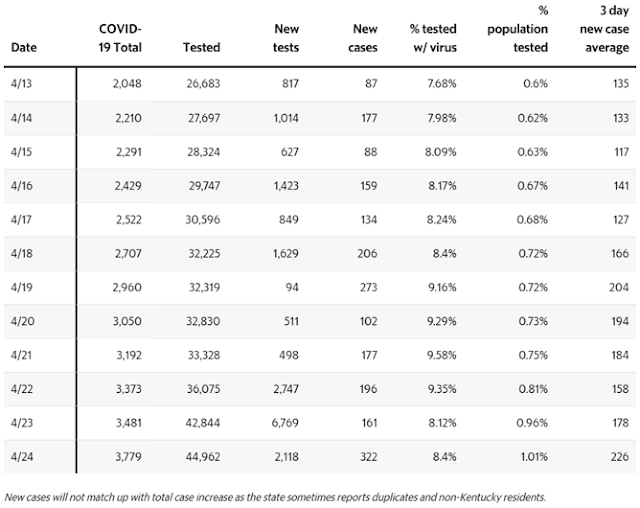So how close is Ky. coming to benchmarks needed to reopen? It’s hard to tell, but Beshear says he will discuss possible dates Mon.

Lexington Herald-Leader chart shows 12 days of metrics Gov. Andy Beshear says he is watching.
—–
Gov. Andy Beshear says he is following benchmarks “to guide his decisions about re-opening Kentucky’s economy during the covid-19 pandemic, but figuring out how to measure the state’s progress has been difficult,” reports Lexington Herald-Leader political writer Daniel Desrochers. “The Democratic governor and his administration have provided scant information about how it is defining and tracking each indicator.”
Beshear said at his daily briefing Sunday that he would talk Monday about possible dates for reopenings, but “It’s gonna be a fluid situation.”
The
seven benchmarks, Desrochers writes, “really boil down to four things: how many people are getting sick from the coronavirus, how many people can be tested for the virus, how many people are available to trace the contacts of infected people, and how much personal protective equipment is available to those who need it.”
The benchmarks follow
guidelines recently issued by the White House and the federal
Centers for Disease Control and Prevention, one of which is “Downward trajectory of documented cases within a 14-day period.” Beshear said Saturday that doesn’t mean the number of cases has to decline each day; he previously spoke of looking at three-day averages, noting that the numbers can vary depending on lab reports, especially on and around weekends.
The next CDC criterion is “Downward trajectory of positive tests as a percent of total tests within a 14-day period.” Desrochers reports, “That number increased steadily from April 12 to April 21, from 7.59 percent to 9.58 percent, before dropping significantly to 8.12 percent on Thursday, when the number of people tested jumped by more than 6,700. It rose to 8.4 percent on Friday. Of those tested over a recent six-day period (April 18-23), 7.2 percent tested positive.”
Increased testing is generally considered the most important hurdle, “so people can be reassured that the guy next to them at work or in the restaurant is not infected,” as U.S. Sen. Mitch McConnell told Bill Bryant of Lexington’s
WKYT-TV in an interview broadcast Sunday.
The CDC guidelines say states should not reopen until they have “Ability to quickly set up safe and efficient screening and testing sites for symptomatic individuals and trace contacts” of those who test positive, and also test to screen “for asymptomatic cases and contacts.”
Kentucky has tested
a smaller percentage of its population than only eight other states; 11 states have found fewer cases. “Since April 13, the state has averaged 1,591 new tests a day, but that is well shy of the 9,000 to 13,000 people the state hopes to be able to test in a single day,” Desrochers reports. “It’s not known how quickly the state might be able to reach that goal, or if re-opening the economy would be halted if the state falls short.”
Beshear said Friday that he hopes for 20,000 tests this week, but his hopes for testing in previous fell short, so some sites were opened to people without symptoms.
Tracing the contacts of people who test positive will require 700 new employees, Beshear said Friday.
The next CDC guideline is the ability of health-care providers “to quickly and independently supply sufficient personal protective equipment and critical medical equipment,” and stockpile enough for a resurgence of cases as social-distancing rules are relaxed. That remains a big problem for Kentucky.
The state’s PPE supply “significantly increased between April 14 and April 21, but it’s not clear how long that supply is expected to last or how much state health officials think they should have on hand,” Desrchers reports. “Beshear said Friday that the state could probably help provide hospitals and nursing homes experiencing critical shortages of PPE for a month, maybe less.”
